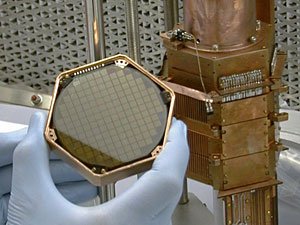Tracking the phantom (advanced explanation)

How CDMS-II researchers hunt for elusive dark matter
By Deane Morrison
A leading theory holds that dark matter consists of particles called WIMPs, or weakly interacting massive particles. They would have been created during the Big Bang, the same as ordinary particles. Eventually, the heavier members of the WIMP family decayed away, leaving lighter forms of the particle that are stable and survive today.
If WIMPs exist, each one exerts a gravitational force on ordinary matter.
"Put together enough WIMPs and enough regular matter, and you can see the gravitational attraction acting on a large scale, even if detecting individual WIMPs is so difficult," says University of Minnesota physics professor Priscilla Cushman.
The only way to do that is to catch them interacting with the nucleus of an atom at extremely close range.
How to build a Universe
According to theory, the Universe consists of approximately 20-25 percent dark matter, 4-5 percent ordinary matter, and the rest "dark energy"--a mysterious force causing the Universe to accelerate its expansion.
If a WIMP, gliding through a solid material, passed close to a nucleus and gave it a bump, it would produce a vibration in the entire solid, similar to ringing a bell. But the ring would be so faint that extraordinarily low temperatures would be necessary to dampen out the thermal background noise.
World's coldest hockey pucks
In CDMS-II, stacks of disks the size of hockey pucks, made of crystalline germanium, are kept in a vacuum thermos chilled to -459.31 degrees F. As the germanium atoms travel with the Earth's movements, they should encounter WIMPs in their path and, occasionally, come close enough to interact with one.
If the two signals were not caused by ordinary interactions, they mean that on two occasions a WIMP "bumped" a germanium nucleus and produced a detectable "ring" in the crystal.
Confirmation of the finding may come from one of several experiments around the world that have been searching for WIMPs, says Cushman. Also, the world's largest particle accelerator—the Large Hadron Collider, in Geneva, Switzerland—could create them as it generates conditions approaching those that that occurred after the Big Bang.
Cushman and Mandic are part of a team gearing up for an even larger experiment, SuperCDMS, which is running improved detectors now at Soudan and will eventually move to an even deeper mine in Canada.
See also a general version of this story, A new form of matter?
